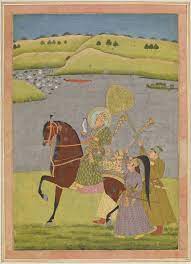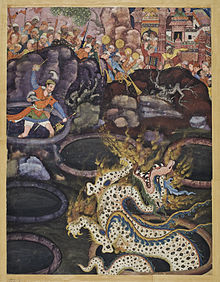175:
77:
171:, the grand vizier of Akbar, mentions in his writings that Daswanth left many masterpieces, but some of the details of Akbar's workshops were not recorded. In the four-volume manuscript, Daswanth drew outlines for fifteen of seventy-four miniatures in the first volume, nine out of seventeen miniatures in the second volume, and six out of sixty miniatures in the third volume. At least thirteen of the paintings he contributed to were in a horizontal format, which is the most in a major Mughal manuscript. This is probably due to that the scenes are of battles.
224:
546:
158:
220:. Additionally, he is named as the designer for many paintings, which would then be completed by others, which is common for the time. His illustrations are often scary and otherworldly, proportionally inconsistent and weightless. Compared to Basawan, his art is full of energy and movement, while Basawan's art had more stabilizing elements.
207:
Chakravyuha (pictured right). It is a double page composition with thousands of figures including soldiers, cavalry, and elephant and chariot riders. They are all arranged in a maze formation and cover the whole page. This was very unique and was not attempted in Mughal art. This is probably due to
94:
have been attributed to him. Two works show partly damaged inscriptions naming him as the artist while a third work has been attributed to him. One of these works is titled the
Wounded Monkey Bites the Hand of the Prince, and depicts the monkey's action and response of the prince and other subjects
240:
He tends to pay special detail to nature and the specific moods of figures. Similarly to other painters of his time, he tends to focus on the storytelling aspect of art. Many of his works depict gory violence and battles, but are still composed with attention paid to diagonals, circles, and other
244:
His art also shows a familiarity with some
Chinese and western painting techniques. Works in the Razmnama called Arjuna shooting the arrow and the seventh adventure of the white horse show western technique and idiom while "Arjuna fells Karna" has Chinese style clouds.
241:
shapes, in balance with the natural surroundings. He often drew gods, demigods, important courtly figures, and warriors. There is also a beautiful understanding of perspective, based on the size of characters, architecture details, and background.
200:, the protagonist of the epic, is pictured in red in the left of the scene near a caldron of hot oil over fire. The intricate facial expressions of the onlooking crowd and details of the fire and grass are indicative of Daswanth's unique style.
99:
131:
One of his works is an equestrian portrait of
Muhammad Shah from the Impey Album. It is a watercolor with gold detailing and a part of three folios and signed by Daswanth.
150:, between 1582-1586, and includes thirty illustrations. If not for his early death, he would have been the most prolific painter on this project which included
61:, a document recording the administration of the Mughal empire, as one of the top three most important artists in this period, and again in the
65:, a book detailing the reign of Akbar, as having great artistic talent. In contrast to 'Abd al Samad, his works were imaginative and original.
622:
174:
617:
46:. After Daswanth showed natural talent by painting and drawing on walls, the emperor learned of him, and he began to be taught by
583:
154:, Makand, Kasu Das, Kanha, and Lal. Multiple scenes he drew were completed by Banwari and he was also assisted by Tulsi Kalan.
607:
453:
417:
112:
where he created multiple paintings, still under the guidance of 'Abd al Samad, and then a singular illustration in the
68:
His behavior was considered erratic in his life time and he wounded himself with a dagger in 1584 which ended his life.
492:
516:
216:
In
Daswanth's illustrations, his chaotic, creative style distinguishes him from other artists of his time, like
184:"Arjun hitting the target" (pictured right) is his first work in the Razmnana. It depicts a crowd of kings in
98:
602:
128:. It's difficult to find specific examples as only about 10% of the Hamza has survived to the present day.
113:
576:
480:
95:
of the scene. His work had a technique of free application of wet pigment which was distinctive.
91:
76:
627:
569:
228:
612:
42:
While not much is known of his early life, it is known that he was Hindu, and the son of a
493:"Equestrian portrait of Muhammad Shah from the Impey Album - National Museum of Asian Art"
8:
365:
290:
459:
449:
413:
357:
282:
349:
223:
557:
233:
116:. It is suspected that he helped to prepare about 1,400 cloth paintings for the
553:
476:
308:
125:
545:
54:
master painter. Abd al-Samad's work was fairly traditional and conservative.
596:
463:
361:
286:
27:
443:
58:
47:
167:
He drew and composed as many as 31 full-page miniatures in the
Razmnama.
147:
157:
146:("Book of wars"), which was a Persian translation of the Hindu epic the
369:
337:
294:
270:
189:
204:
168:
117:
109:
62:
43:
353:
193:
143:
87:
51:
309:"Dasvant | Modern Art, Post-Impressionism, Symbolism | Britannica"
217:
185:
151:
197:
31:
121:
142:
The largest collection of
Daswanth's work is found in the
103:
Equestrian portrait of
Muhammad Shah from the Impey Album
445:
The Grove encyclopedia of
Islamic art and architecture
108:
His next important artistic contribution was to the
448:. Oxford ; New York: Oxford University Press.
594:
412:. Marg publications. Mumbai: Marg Publications.
196:, would pick a husband from a crowd of suitors.
577:
442:Bloom, Jonathan; Blair, Sheila, eds. (2009).
81:The wounded monkey bites prince from Tutinama
203:One impressive scene painted by Daswanth is
30:-era painter in the service of the emperor
584:
570:
441:
179:Chakravyuha: the tragic death of Abhimanyu
222:
173:
156:
97:
75:
342:The Metropolitan Museum of Art Bulletin
338:"Mughal Painting under Akbar the Great"
120:and some embellishment on buildings in
595:
335:
403:
401:
399:
268:
540:
437:
435:
433:
431:
429:
397:
395:
393:
391:
389:
387:
385:
383:
381:
379:
331:
329:
264:
262:
260:
258:
407:
13:
552:This article about a painter is a
14:
639:
623:16th-century Mughal Empire people
426:
376:
326:
255:
211:
544:
208:that the scenes are of battles.
188:capital for a ceremony called a
618:Painters from the Mughal Empire
410:Mughal masters: further studies
192:, where a woman, in this case,
134:
509:
485:
470:
301:
269:Beach, Milo Cleveland (1982).
57:Daswanth is referenced in the
1:
408:Das, Asok Kumar, ed. (1998).
271:"The Mughal Painter Daswanth"
248:
608:16th-century Indian painters
556:. You can help Knowledge by
114:Tarikh e Khandan e Timuriyah
7:
336:Dimand, Maurice S. (1953).
86:Three illustrations of the
10:
644:
539:
26:(b. 1560 - d. 1584) was a
71:
481:Encyclopædia Britannica
92:Cleveland Museum of Art
90:("Parrot Book") at the
37:
237:
181:
164:
105:
83:
229:Umar Defeats a Dragon
226:
177:
162:Arjun hits the target
160:
101:
79:
48:Khwāja 'Abd al-Samad
603:16th-century births
118:Dastan-i Amir Hamza
313:www.britannica.com
238:
182:
165:
106:
84:
565:
564:
455:978-0-19-530991-1
419:978-81-85026-40-4
635:
586:
579:
572:
548:
541:
531:
530:
528:
527:
521:Oxford Reference
513:
507:
506:
504:
503:
489:
483:
474:
468:
467:
439:
424:
423:
405:
374:
373:
333:
324:
323:
321:
320:
305:
299:
298:
266:
44:palanquin-bearer
643:
642:
638:
637:
636:
634:
633:
632:
593:
592:
591:
590:
537:
535:
534:
525:
523:
515:
514:
510:
501:
499:
491:
490:
486:
475:
471:
456:
440:
427:
420:
406:
377:
354:10.2307/3257529
334:
327:
318:
316:
307:
306:
302:
267:
256:
251:
234:Akbar Hamzanama
214:
140:
74:
40:
17:
12:
11:
5:
641:
631:
630:
625:
620:
615:
610:
605:
589:
588:
581:
574:
566:
563:
562:
549:
533:
532:
508:
484:
469:
454:
425:
418:
375:
325:
300:
275:Ars Orientalis
253:
252:
250:
247:
213:
212:Artistic style
210:
186:King Drupada's
139:
133:
126:Fatehpur Sikri
73:
70:
39:
36:
16:Mughal Painter
15:
9:
6:
4:
3:
2:
640:
629:
628:Painter stubs
626:
624:
621:
619:
616:
614:
611:
609:
606:
604:
601:
600:
598:
587:
582:
580:
575:
573:
568:
567:
561:
559:
555:
550:
547:
543:
542:
538:
522:
518:
517:"Tulsi Kalan"
512:
498:
494:
488:
482:
478:
473:
465:
461:
457:
451:
447:
446:
438:
436:
434:
432:
430:
421:
415:
411:
404:
402:
400:
398:
396:
394:
392:
390:
388:
386:
384:
382:
380:
371:
367:
363:
359:
355:
351:
347:
343:
339:
332:
330:
314:
310:
304:
296:
292:
288:
284:
280:
276:
272:
265:
263:
261:
259:
254:
246:
242:
235:
231:
230:
225:
221:
219:
209:
206:
201:
199:
195:
191:
187:
180:
176:
172:
170:
163:
159:
155:
153:
149:
145:
138:
132:
129:
127:
123:
119:
115:
111:
104:
100:
96:
93:
89:
82:
78:
69:
66:
64:
60:
55:
53:
49:
45:
35:
33:
29:
25:
21:
558:expanding it
551:
536:
524:. Retrieved
520:
511:
500:. Retrieved
496:
487:
472:
444:
409:
348:(2): 46–51.
345:
341:
317:. Retrieved
315:. 2024-02-26
312:
303:
278:
274:
243:
239:
227:
215:
202:
183:
178:
166:
161:
141:
136:
130:
107:
102:
85:
80:
67:
59:Ain-i-Akbari
56:
41:
23:
19:
18:
613:1584 deaths
497:asia.si.edu
281:: 121–133.
232:, from the
205:Abhimanyu's
148:Mahabharata
597:Categories
526:2024-04-19
502:2024-04-19
319:2024-04-19
249:References
236:manuscript
190:svayamvara
464:232605788
362:0026-1521
287:0571-1371
169:Abul Fazl
63:Akbarnama
194:Draupadi
144:Razmnama
137:Razmnama
110:Hazanama
88:Tūtīnāma
24:Dasavant
20:Daswanth
479:in the
477:Dasvant
370:3257529
295:4629314
218:Basawan
152:Basawan
52:Persian
462:
452:
416:
368:
360:
293:
285:
198:Arjuna
28:Mughal
366:JSTOR
291:JSTOR
72:Works
32:Akbar
554:stub
460:OCLC
450:ISBN
414:ISBN
358:ISSN
283:ISSN
135:The
124:and
122:Agra
50:, a
38:Life
350:doi
22:or
599::
519:.
495:.
458:.
428:^
378:^
364:.
356:.
346:12
344:.
340:.
328:^
311:.
289:.
279:13
277:.
273:.
257:^
34:.
585:e
578:t
571:v
560:.
529:.
505:.
466:.
422:.
372:.
352::
322:.
297:.
Text is available under the Creative Commons Attribution-ShareAlike License. Additional terms may apply.




